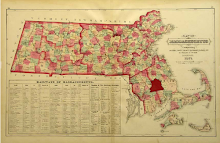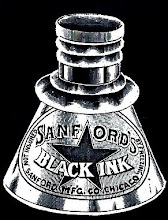 Despite its rich animal life, the Pratt Farm offers even greater diversity in the variety of flora it contains, and the conservation area is a veritable botanical garden for those who wish to explore its plant life which speaks to both the natural and cultural history of the farm.
Despite its rich animal life, the Pratt Farm offers even greater diversity in the variety of flora it contains, and the conservation area is a veritable botanical garden for those who wish to explore its plant life which speaks to both the natural and cultural history of the farm.Ironically the profusion of wildflowers which attract butterflies and other insects to the meadows of the Pratt Farm today was considered a matter of grave concern a century earlier when the land was being used to raise fodder such as hay and other grasses. The invasion of what were commonly considered weeds at the expense of commercially-valuable feed grains severely compromised the quality of the crops produced. “The loss from weeds, though not one that can be computed nor even guessed at, is undoubtedly very large, and their growth is a great hindrance to farming, a fact which must impress itself upon every man of observation", wrote one Massachusetts commentator in 1884.
In 1896, botanist G. E. Stone of the Massachusetts Agricultural College, now the University of Massachusetts at Amherst, listed a number of common weeds that should be eradicated from Massachusetts fields, and encouraged farmers to root them out, including a number which today are commonly found in the abandoned hay fields of the Pratt Farm such as ramsted, Queen Anne’s lace and daisy fleabane. Interestingly, Stone believed that the black-eyed Susan would not find a hold in Massachusetts, yet its presence in all the fields at the Pratt Farm belies Stone’s supposition.
Other plants on the farm are native species which historically had neither value as forage crops nor interfered with the cultivation of such crops. Occurring throughout the farm, however, these plants added beauty and diversity to the landscape. Among them is sweet Joe-Pye weed. While the origin of the plant's name is uncertain, some claim that it is named for Joe Pye, a Native American herbalist who cured typhus with the plant. Be that as it may, the tale does underscore the importance of such plants to native peoples.
Louise Pratt recollected the beauty of the "late asters", no doubt having the late-blooming New England aster in mind. What a delightful place the farm was for us to grow up. We roamed the fields and woods…. We knew where the wildflowers grew, from the early Jack-in-the-Pulpit to the late wild asters. New England asters are noted in several locations about the farm and are attractive in that they are one of the last plants to bloom in the year.
The presence of cardinal flower is betrayed by its conspicuously brilliant color. Thoreau once queried of the flower, "'Thy sins shall be as scarlet.' Is it my sins that I see?" The plant appears in limited areas of the Pratt Farm, blooming in August. Cardinal flower is an endangered species in Massachusetts and should not be picked. It is protected under the same 1935 law which protects lady slippers.
Chapter 266 of the General Laws is hereby amended by inserting after Section 116, as appearing in the Tercentenary Edition, the following new section:--Section 116A. No person shall pull up or dig up the plant of a wild azalea, wild orchid or cardinal flower (Lobelia cardinalis), or any part thereof, or injure any such plant or any part thereof except in so far as is reasonably necessary in procuring the flower therefrom, within the limits of any state highway or any other public way or place, or upon the land of another person without the written authority from him, and no person shall buy or sell, or offer or expose for sale, any such flower, or the whole of any part of the plant thereof, knowing or having reasonable cause to believe, that in procuring such flower or plant the foregoing provisions have been violated. Violation of any provision of this section shall be punished by a fine of not more than five dollars."
Chicory is perhaps best known as a coffee substitute. Its use was widespread among Confederate soldiers during the Civil War as well as during the Great Depression. Though probably not used as livestock forage on the Pratt Farm, this use for the plant is increasingly gaining acceptance.
Butterflies Pollinating Milkweed, Pratt Farm, Middleborough, MA, photograph by Mike Maddigan, July 3, 2005
Ramsted, Pratt Farm, Middleborough, MA, photograph by Mike Maddigan, September 26, 2011
Daisy Fleabane, Pratt Farm, Middleborough, MA, photograph by Mike Maddigan, July 7, 2005
Yellow Foxtail, Pratt Farm, Middleborough, MA, photograph by Mike Maddigan, September 6, 2004
Alfalfa, Pratt Farm, Middleborough, MA, photograph by Mike Maddigan, August 24, 2004
Cow Vetch, Pratt Farm, Middleborough, MA, photograph by Mike Maddigan, August 5, 2004
Hop Clover, Pratt Farm, Middleborough, MA, photograph by Mike Maddigan, summer 2004
Sweet Joe-Pye Weed, Pratt Farm, Middleborough, MA, photograph by Mike Maddigan, August 30, 2004
New England Aster, Pratt Farm, Middleborough, MA, photograph by Mike Maddigan, October 17, 2011
Cardinal Flower, Pratt Farm, Middleborough, MA, photograph by Mike Maddigan, August 9, 2004
Chicory, Pratt Farm, Middleborough, MA, photograph by Mike Maddigan, September 10, 2004

































+of+Smoky+Mountains+018.jpg)
0 comments:
Post a Comment